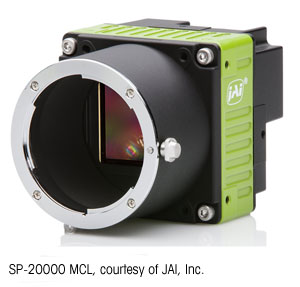
Color machine vision has its challenges.
Systems can produce three times the data (or less than one-third the resolution) of a monochrome camera solution. Color can introduce more potential sources for imaging errors, more complexity, more cost, and require careful engineering that reduces the system’s flexibility to deal with lines that make products of varying shape, colors, and size. In fact, if designers can find a way to use filters and lighting to measure a colored area using monochrome cameras, they usually do.
However, for many applications ranging from electronic manufacturing to printing and food processing, color is the only way to solve the problem. Let’s look at some of the considerations a system design needs to take into account to create a successful color machine vision solution, including careful matching of camera, optics, and light source.
Is Three Company?
“JAI has solid offerings on both sides of color, meaning single-chip Bayer filter color cameras and color cameras with three CCD sensors or more, including a four-line multispectral color camera that offers separate sensors for red, green, blue, and near infrared,” explains Steve Kinney, Director of Technical Pre-Sales and Support at JAI Inc., USA (San Jose, California).
When customers come to JAI to discuss a color application, Kinney starts by asking what sort of spatial accuracy the system needs versus color accuracy. “It also depends on data rate,” he adds. “If you need absolute color accuracy of less than 1%, then we usually look at a three-CCD prism camera solution. If spatial accuracy over a wide inspection area is more important, then a very-high-resolution single-chip Bayer camera may be better. If you need high speed, CMOS offers higher frame rates and multi-line sensors with NIR capability and is very effective for high-speed printing applications where colorimetry measurements are very important because NIR can help you judge between true black ink and black made by combining cyan-magenta-yellow inks. And for some printing applications, knowing the difference is important for quality purposes.”
Today, printed circuit boards require more color vision solutions because the color of a component helps to identify each part. Plugs and connectors are color coded, and at the same time, the board is tracked using a black-and-white barcode. “These applications used to be done with a high-resolution monochrome camera, but now, you need to be able to sense color to make sure the right component and connector are in the right place,” Kinney explains. “The barcode will usually be located at the edge of the frame. If you use a single-chip color camera, you have to be concerned about color shading and halos at the edge of the image, and it’s made worse if you use cheap optics.”
refer to:http://www.visiononline.org/vision-resources-details.cfm/vision-resources/Is-Your-Machine-Vision-System-Color-Blind/content_id/4333
